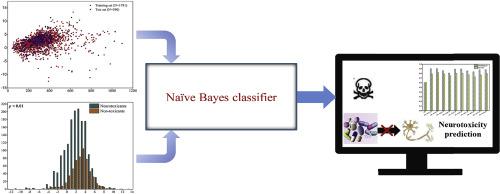Food and Chemical Toxicology ( IF 4.3 ) Pub Date : 2020-07-01 , DOI: 10.1016/j.fct.2020.111513 Hui Zhang 1 , Jun Mao 2 , Hua-Zhao Qi 2 , Huan-Zhang Xie 3 , Chen Shen 2 , Chun-Tao Liu 2 , Lan Ding 2

|
Development of reliable and efficient alternative in vivo methods for evaluation of the chemicals with potential neurotoxicity is an urgent need in the early stages of drug design. In this investigation, the computational prediction models for drug-induced neurotoxicity were developed by using the classical naïve Bayes classifier. Eight molecular properties closely relevant to neurotoxicity were selected. Then, 110 classification models were developed with using the eight important molecular descriptors and 10 types of fingerprints with 11 different maximum diameters. Among these 110 prediction models, the prediction model (NB-03) based on eight molecular descriptors combined with ECFP_10 fingerprints showed the best prediction performance, which gave 90.5% overall prediction accuracy for the training set and 82.1% concordance for the external test set. In addition, compared to naïve Bayes classifier, the recursive partitioning classifier displayed worse predictive performance for neurotoxicity. Therefore, the established NB-03 prediction model can be used as a reliable virtual screening tool to predict neurotoxicity in the early stages of drug design. Moreover, some structure alerts for characterizing neurotoxicity were identified in this research, which could give an important guidance for the chemists in structural modification and optimization to reduce the chemicals with potential neurotoxicity.
中文翻译:

使用朴素的贝叶斯分类器技术开发用于评估化学诱导的神经毒性的新型计算预测模型。
开发可靠,有效的体内替代药物在药物设计的早期阶段,迫切需要用于评估具有潜在神经毒性的化学物质的方法。在这项研究中,使用经典朴素贝叶斯分类器开发了药物诱导的神经毒性的计算预测模型。选择了与神经毒性密切相关的八个分子特性。然后,使用八个重要的分子描述符和十种具有11种不同最大直径的指纹,开发了110个分类模型。在这110种预测模型中,基于8个分子描述符并结合ECFP_10指纹的预测模型(NB-03)显示出最佳的预测性能,该模型对训练集的整体预测准确性为90.5%,对于外部测试集的一致性为82.1%。此外,与朴素的贝叶斯分类器相比,递归分区分类器对神经毒性的预测性能较差。因此,已建立的NB-03预测模型可以用作预测药物设计早期阶段神经毒性的可靠虚拟筛选工具。此外,在这项研究中鉴定出一些表征神经毒性的结构警报,这可以为化学家进行结构修饰和优化以减少具有潜在神经毒性的化学物质提供重要指导。


























 京公网安备 11010802027423号
京公网安备 11010802027423号